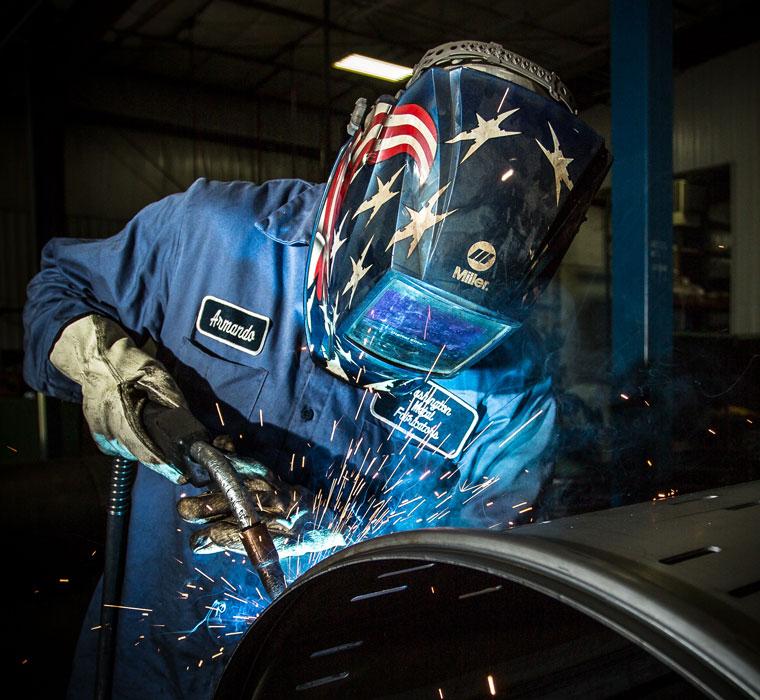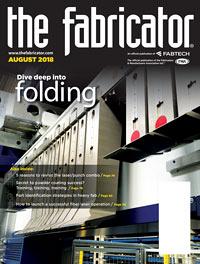Senior Editor
- FMA
- The Fabricator
- FABTECH
- Canadian Metalworking
Categories
- Additive Manufacturing
- Aluminum Welding
- Arc Welding
- Assembly and Joining
- Automation and Robotics
- Bending and Forming
- Consumables
- Cutting and Weld Prep
- Electric Vehicles
- En Español
- Finishing
- Hydroforming
- Laser Cutting
- Laser Welding
- Machining
- Manufacturing Software
- Materials Handling
- Metals/Materials
- Oxyfuel Cutting
- Plasma Cutting
- Power Tools
- Punching and Other Holemaking
- Roll Forming
- Safety
- Sawing
- Shearing
- Shop Management
- Testing and Measuring
- Tube and Pipe Fabrication
- Tube and Pipe Production
- Waterjet Cutting
Industry Directory
Webcasts
Podcasts
FAB 40
Advertise
Subscribe
Account Login
Search
Why collaboration is critical in metal fabrication
Two shops exemplify how connected the industry really is
- By Tim Heston
- August 7, 2018
- Article
- Shop Management
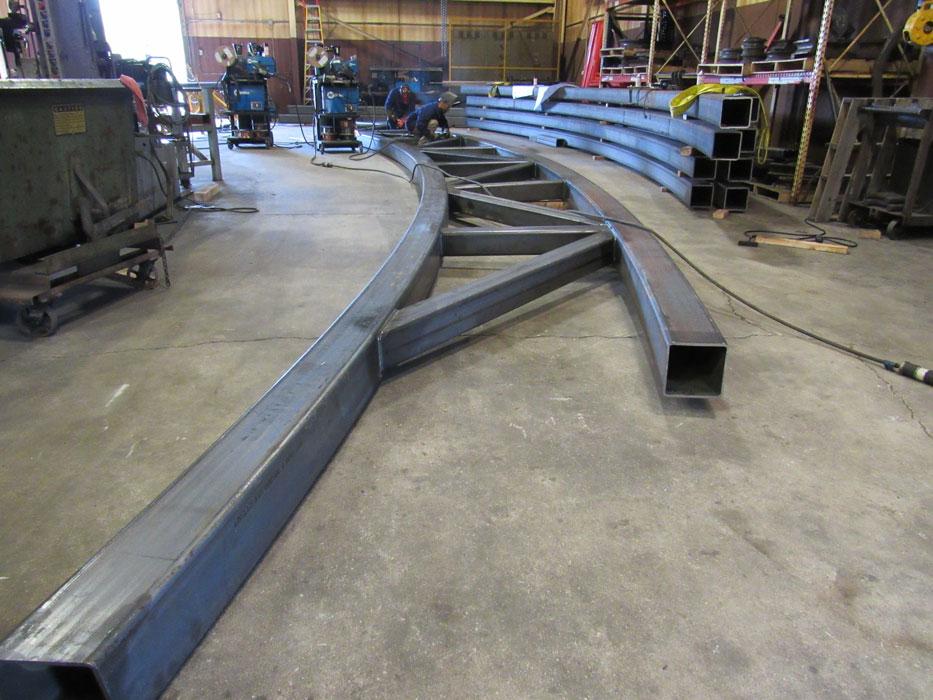
Welders at Max Weiss fabricate a rolled section. Such value-added services make life easier for customers. Photo courtesy of Max Weiss Co.
When metal fabricators find their niche, they can thrive. If you work for a sheet metal fabricator specializing in, say, store fixtures, you analyze the demands of that market and diversify based on those strengths—right? That means quick response, quick prototyping, engineers who make suggestions and perform some design for manufacturability (DFM), and a shop tailored for low-volume production with a plethora of quick changeovers.
A lot of markets demand those things, so it makes sense to diversify. And that’s just what the custom fabricator does. As its customer base diversifies, so does its capabilities. The shop may have started out with a punch or burn table, a press brake, and a welding cell. Pretty soon it brings in rolling, perhaps some powder coating, maybe some milling and turning. What was once outsourced is now brought in-house. Is the shop competing with its subcontractors, like the custom coater or machine shop down the street, or is it just the nature of the web of modern manufacturing?
It’s likely the latter, as supported by the stories behind two very different companies: Washington Metal Fabricators, a custom sheet metal fabricator in Washington, Mo., west of St. Louis, and Max Weiss, a 35-employee rolling shop in Milwaukee.
Both evolved significantly over time, starting with niches that grew. The two companies live in different parts of the metal fabrication web, but they experience the same benefits, like not being tied to a single industry, and challenges, like having to meet short lead times, juggling diverse customer demands, finding good people, and breaking into new markets.
The two companies show that although metal fabrication is a business founded on technology, relationships make it sustainable. Those relationships help build the strands of the web, and they help make everyone connected with the fabricator—customers and suppliers alike—much stronger. In any business, and especially in the highly interconnected world of metal fabrication, those strands mean everything.
Rolling It Right
Several years ago Dan Weiss sat down to write a letter, an old-school one placed in an envelope and mailed to Merrill Steel, a nearby structural fabricator. Merrill had bid on the new Milwaukee Bucks arena that was slated to be built, and Weiss wrote that if there was anything his roll bending shop could do, Max Weiss Co. would be there. “We leveraged our relationship,” said Al Sanders, Max Weiss’ vice president of sales. “We had a personal touch. We don’t know if it helped us ultimately win the work, but we like to think it did.”
Merrill and Max Weiss Co. have worked together often; their planners and engineers know each other well. The two organizations working together become seamless, and that’s just what happened when the two collaborated to build the Milwaukee Bucks stadium. Using a Davi horizontal three-roll system, Max Weiss bent 20- by 4-in., 0.5-in.-wall structural tubing, made of A500 Grade B, to a 40-ft. outside radius.
A job shop can be a quixotic place. It’s the nature of the beast, or at least that’s the common assumption, but several years ago Max Weiss managers tackled one of the root causes of the “controlled chaos” that anyone in a job shop probably knows all too well. Its customer list consists of thousands of companies, but most of those customers don’t have a consistent need for rolling. A few do, however, and that core customer base represents the core strands of the “web of business” that supports Max Weiss and helps it grow.
These are the “gold” customers, and Merrill happens to be one of them. The company then has its silver customers, who order less frequently, and bronze customers, who order even less frequently—the “long tail” of a typical job shop’s customer base.
“We’re constantly evaluating our customer base and identifying companies that help us get further down the road,” Sanders said, “so we can grow together.”

An assembler at Washington Metal Fabricators puts the final touches on a piece of equipment that is ready to be shipped not to the customer, but to the customer’s customer. Photo courtesy of Washington Metal Fabricators.
Sanders clarified that this is not to say the “long tail” of bronze customers isn’t valued. They do help diversify revenue. But the orders come in sporadically and in low volumes, and operationally those orders are handled differently.
Max Weiss operates with some reserve capacity. If the company needs to dip into that reserve capacity, it’s likely to be for at least a silver customer. If Max Weiss needs to bend over backward, work significant overtime, and do whatever it takes to get the job done, that’s likely to be for a gold customer.
Such “customer ranking” isn’t unusual in the job shop business, of course. It’s sometimes considered a necessity, considering the business’s high demand variability. But Max Weiss went a step farther by putting a formal process behind it, so each customer is clearly defined. This affects promise dates and work priority on the floor.
The goal is to not overpromise and underdeliver to anyone who does business with the roll shop. Word about poor service gets around. Breaking promises to bronze customers might prevent that customer from coming back. Breaking promises made to gold customers can fray the very strands of the web that’s supporting the business.
Max Weiss has also ventured outside rolling to offer cutting and welding, services historically handled by its fabricator customer base. By offering these services, though, isn’t the roller competing with its customers? According to Sanders, not really. The company offers fabrication when customers need it. It’s value that Max Weiss can provide that helps the company grow, which in turn can help it better service its core structural fabrication customers.
Besides, cutting, rolling, and welding curved sections together make life easier for many of Max Weiss’ customers. Instead of simply receiving rolled sections, the fabricator receives a rolled and welded assembly, all built within specified tolerances, that then can be joined to a larger assembly, either at the customer’s shop or at the construction site.
Offering fabrication also helps the company compete in areas outside construction, which the company feels is essential for the firm’s long-term success. “In 2009, when construction took a nosedive, it was a bad time,” Sanders said. “We learned a lot.”
Since then the company has expanded beyond construction to become a supplier in the industrial and OEM supply chain. Today about a quarter of Max Weiss’ revenue comes from the industrial and OEM market.
To expand there, Max Weiss sells its ability to take on not just any job, but challenging jobs. After all, OEMs and their larger suppliers have somewhat consistent demand, at least relative to construction work, and if that demand becomes large enough, it sometimes makes sense for the manufacturers themselves to invest in rolling equipment.
Max Weiss has invested in a Davi CNC plate roll. “It can put multiple radii in a single piece,” Sanders said, “and it’s repeatable.”
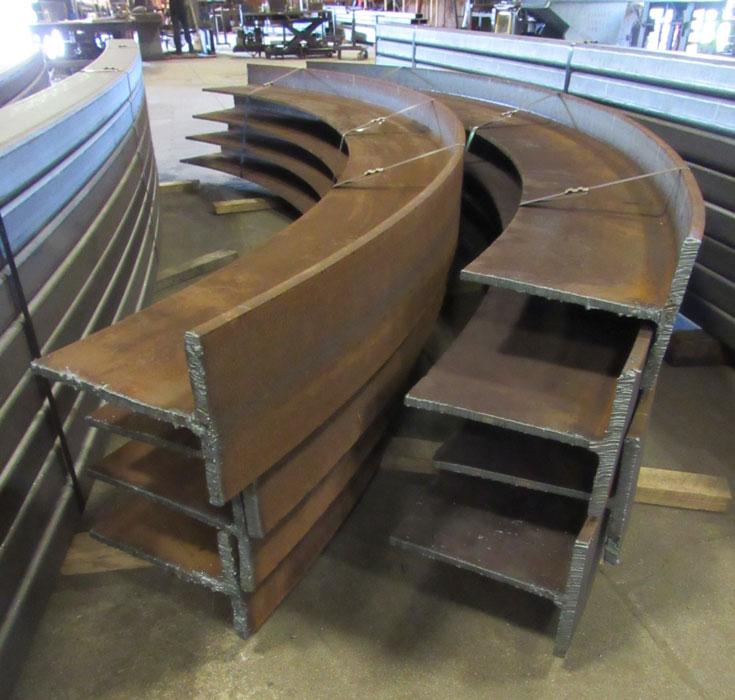
Max Weiss specializes in difficult structural rolling, including these beams—rolled the hard way. Photo courtesy of Max Weiss Co.
He added that millennials like running the “new and shiny” machine. In fact, it’s become a good training ground for new employees to learn the nature of rolling. But the nature of rolling remains complex. It’s a technology that’s still not dominated by the CNC. Volumes are too low and bending variables (including material tensile variation) are just too numerous.
That knowledge, of course, is why customers come to Max Weiss. An OEM could invest in a machine and employ a roller operator. But rolling a workpiece isn’t like cutting plate on a burn table, which takes just seconds.
Rolling a large workpiece can take hours, and trained operators know just how far to push the metal, be it plate, tube, or a structural shape. They perform a sufficient number of rolling passes to ensure the workpiece emerges without wrinkling, twisting, or other distortion. At the same time, they bend it as efficiently as they can, using no more rolling passes than absolutely needed.
The rectangular tubes—bent the hard way (along the longer axis)—made for the Milwaukee Bucks arena is a prime example. After rolling, those sections lay entirely flat on the floor. “A less experienced operator might have been too aggressive on the first bending pass, causing the material to move out of the dies,” Sanders said. “It takes a good eye to know how much to bend.”
A bad part in roll bending becomes extraordinarily expensive scrap, too, both in time and material. It’s not unusual for a large part to take 90 minutes to bend and cost tens of thousands of dollars in material alone.
That’s a lot of risk to take on, but not if you have the right people with the right rolling experience. Max Weiss and the roll shops like it have built a business around it.
But again, Max Weiss can’t operate as an island. Consider again the Milwaukee Bucks arena job. These large bent sections couldn’t be taken outside simply because the curved pieces really couldn’t be lifted reliably by the company’s fork truck. So Max Weiss used its overhead cranes to move them to the delivery area on the shop floor, then worked closely with Merrill on logistics, scheduling trucks for just-in-time pickup and delivery, freeing up space so that the rollers could start churning out more pieces. In the web of metal fabrication, that’s a strong strand at work.
Not for Pigeonholing
Sales at Washington Metal Fabricators (WMF) have risen 40 percent over the past three years, though President Doug Olds qualified that statement. “We’ve done well, but we’re up 40 percent this year because things were down. We’re now back where we should be.”
The revenue mix at WMF has changed in recent years. The 125-employee fabricator serves diverse markets that the company groups into three areas: store fixtures, reservoir tanks for the electrical distribution industry (and others), then jobs grouped under the catch-all “fabrication” division. “That’s everything else,” Olds said. “Fabrication is the biggest by far. It’s always fun around here because you never know what’s going to happen. We have so many different, eclectic projects. Today I worked on a job associated with truck axles, and yesterday I worked on a big sporting goods piece of equipment.
“If an opportunity presents itself, we look at it,” he continued. “We don’t narrow ourselves into a pigeonhole.”
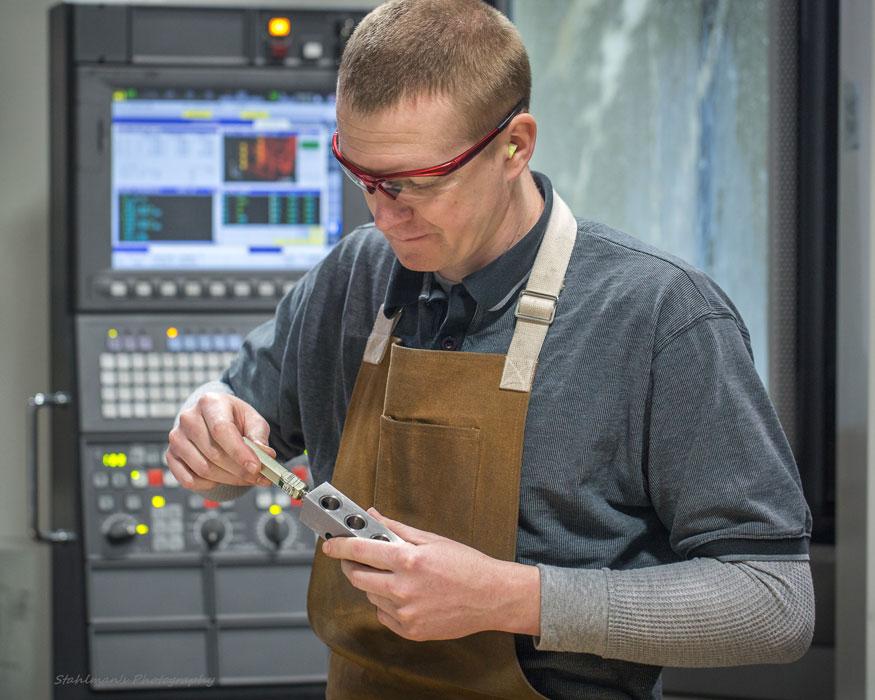
A machining operator checks a first article. Washington Metal Fabricators brought in machining capability more than a year ago. Photo courtesy of Washington Metal Fabricators.
At one point store fixtures made up more than 50 percent of WMF’s business. In the 1990s the fabricator sold fixtures to distributors. Then over the years more low-end fixture work went to China and the domestic industry shifted toward high-end fixtures for high-end retail chains. Now, as retail stores are closing faster than they’re being built, the store fixture business has changed dramatically. Washington today still does a fair number of fixtures for specialty retail like car dealerships as well as restaurants.
Of course, the company wouldn’t have grown sales 40 percent if it didn’t diversify, and most of that new business hasn’t come from straightforward make-to-print jobs.
“Most of our customers don’t even see the products anymore.”
Olds is describing the company’s private-label contract manufacturing work, for which WMF not only fabricates, but also handles logistics for customers. Search The FABRICATOR archives and you’ll find this is becoming a common service, even at some very small custom fab shops.
Some, WMF included, go a step farther and handle the manufacturing supply chain both upstream and downstream. That is, they manage parts coming in to fabricate and assemble the unit, and they handle the warehousing and distribution, sending products directly to customers’ customers.
“In a sense we’ve always been focusing on our distribution services, but we’re now focusing on it more than we have in the past,” Olds explained. “For instance, we’ve had products that we ship down to a customer’s facility in Texas, where the customer then sends it to New York. That just doesn’t make sense. Why pay the freight companies?”
Like many fabricators, the company has brought other manufacturing processes in-house, including powder coating and, most recently, machining. Of course, in Washington and elsewhere around the St. Louis metro area, machine shops abound. Did bringing in those outside processes hurt those relationships with subcontractors? Olds answered just like Sanders did.
“Not really. Our subcontractors helped us get to where we are today. We were just honest with our powder coating and machining providers. And they knew that bringing more processes in-house would help us grow. And with that growth, we actually have more work to send to our subcontractors.”
Relationships also happen to be a silver lining in an otherwise challenging situation: rising material pricing and the tumultuous politics and trade saber rattling that add more uncertainty to the industry. These days prospects are calling to check to see if WMF can offer a better deal. Those calls don’t always end up as a sale, of course, but the situation is at least increasing customer contact. “If people are coming to us for any reason, it’s an opportunity,” Olds said.
Two Shops, Same Web
In many respects Max Weiss and WMF couldn’t be more different. Max Weiss has massive Davi plate and angle rollers, while WMF has a plethora of TRUMPF sheet metal cutting and bending equipment.
WMF fabricates a spectrum of make-to-order projects, many sent directly to customers, others replenished in a warehouse, where WMF keeps an agreed-upon amount of stock. Max Weiss fabricates massive workpieces that must be moved to the job site in short order. Max Weiss is also at home in the construction market though it is increasing its presence in the industrial equipment arena. WMF grew as a store fixture fabricator but now has evolved into something much more.
Each is ensuring the strands making up the web of fabrication stay strong. Although that web is built with technology, it’s held together with good customer relationships.
Max Weiss Co., www.maxweiss.com
Washington Metal Fabricators, www. washmetfab.com
About the Author

Tim Heston
2135 Point Blvd
Elgin, IL 60123
815-381-1314
Tim Heston, The Fabricator's senior editor, has covered the metal fabrication industry since 1998, starting his career at the American Welding Society's Welding Journal. Since then he has covered the full range of metal fabrication processes, from stamping, bending, and cutting to grinding and polishing. He joined The Fabricator's staff in October 2007.
Related Companies
subscribe now

The Fabricator is North America's leading magazine for the metal forming and fabricating industry. The magazine delivers the news, technical articles, and case histories that enable fabricators to do their jobs more efficiently. The Fabricator has served the industry since 1970.
start your free subscription- Stay connected from anywhere

Easily access valuable industry resources now with full access to the digital edition of The Fabricator.

Easily access valuable industry resources now with full access to the digital edition of The Welder.

Easily access valuable industry resources now with full access to the digital edition of The Tube and Pipe Journal.
- Podcasting
- Podcast:
- The Fabricator Podcast
- Published:
- 04/16/2024
- Running Time:
- 63:29
In this episode of The Fabricator Podcast, Caleb Chamberlain, co-founder and CEO of OSH Cut, discusses his company’s...
- Industry Events
16th Annual Safety Conference
- April 30 - May 1, 2024
- Elgin,
Pipe and Tube Conference
- May 21 - 22, 2024
- Omaha, NE
World-Class Roll Forming Workshop
- June 5 - 6, 2024
- Louisville, KY
Advanced Laser Application Workshop
- June 25 - 27, 2024
- Novi, MI
























